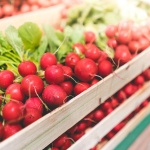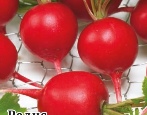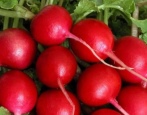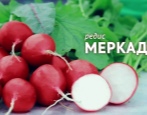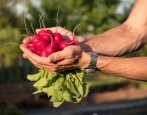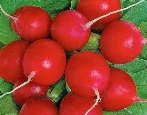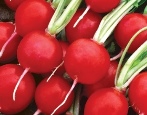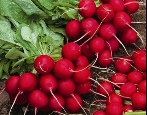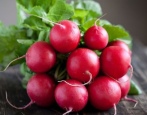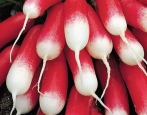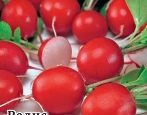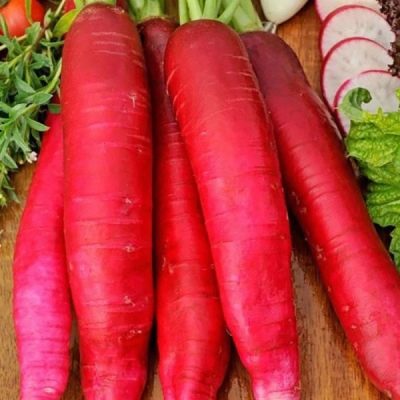
- Year of approval: 1958
- Ripening terms: mid-season
- The form: elongated-cylindrical
- Coloration: red with white-pink transverse striation
- Weight, g: 50-80
- Color of the pulp: white
- Pulp (consistency): juicy
- Taste qualities: excellent
- Average yield: 4-4.5 kg / m2
- Yield: high
Radish of the Red Giant variety has been known since 1958. It was bred by breeders of the Far Eastern experimental station VNIIR. But even today this variety is very popular among gardeners because of its high yield, excellent taste and resistance to low temperatures.
Description of the variety
The red giant is intended for cultivation in open and protected ground. It is a highly productive variety for summer sowing. Root crops are slightly raised above the soil surface. The Red Giant is characterized by resistance to flowering. In general, the variety is characterized by cold resistance, it can be successfully grown not only in the central regions of Russia, but also in the northern, as well as in the East Siberian and Far Eastern regions.
Characteristics of the appearance of the plant and root crops
Radish The Red Giant is a medium-sized plant. The rosette is erect, thin, and grows vertically upward. Few leaves (7-12 pieces) are slightly pubescent, oval and green in color. The variety has a highly developed root system.
Root crops of the Red Giant variety are large, elongated-cylindrical in shape, have a diameter of 2.5-3.5 cm.The length reaches about 11-13 cm, the mass of one tuber is 50-80 g. Root crops are colored red with a white-pink transverse furrowing. They are also characterized by evenness and excellent presentation.
Purpose and taste of tubers
The pulp of this variety is very juicy, has a rich white color. The red giant is famous for its excellent taste. It has a sweet-spicy taste, without bitterness. Ideal for fresh consumption. Root crops are suitable for storage for 2-3 months, they are not characterized by fast flabbiness.
Maturation
Radish Red giant belongs to mid-season varieties. At least 40 days should elapse from germination to harvest. It should be borne in mind that the duration of ripening directly depends on the timing of sowing and on the illumination of the plants.
Yield
This variety is characterized by a high yield. Average values are 4-4.5 kg / m2.
Growing and care
The Red Giant variety is generally unpretentious, but has its own growth characteristics that allow you to get a good harvest. A sunny site should be chosen as a landing site, the soil should be sandy loam, loose and slightly acidic. In the fall, humus and compost fertilizer must be applied to the proposed landing site of the Red Giant. Since the variety has elongated roots, the soil must be well cultivated to a depth of 18-20 cm.
You can plant seeds in open ground from early April to October, but the optimal time is mid-July. Seed material planted in spring can be covered with foil for 9-11 days to speed up germination.
It is recommended to follow the planting scheme 15x7 cm, the depth of planting seeds is 1-1.5 cm. Care consists in timely regular watering 2-3 times a week and loosening the soil. From mineral fertilizers, it is better to give preference to superphosphate and potassium salt.
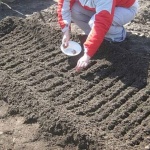

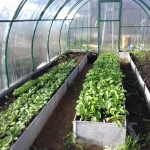
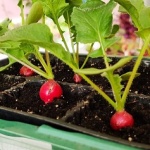
Disease and pest resistance
Radish Red giant is quite resistant to the attack of cruciferous flea beetles, it has average immunity to other diseases. May be affected by downy mildew when planted in a too humid place with poor ventilation. In the season of heavy rains, black spot often appears on the plants; for prevention purposes, the seeds can be treated with fungicides.
A red giant grown in greenhouses in conditions of excessive humidity can be affected by a black leg, so it is necessary to add the biological product "Trichodermin" to the greenhouse soil. Experienced gardeners do not recommend planting radishes in the place where other crops of the Cruciferous family grew before, as they can transmit many diseases to radishes through the soil.

